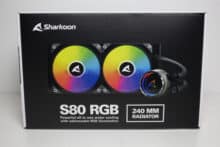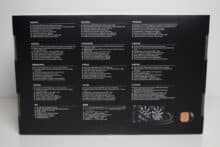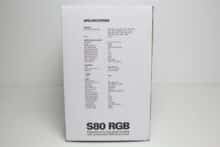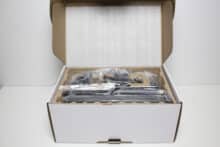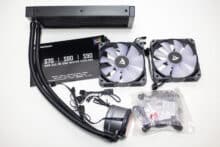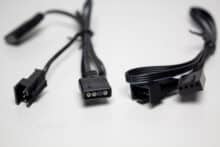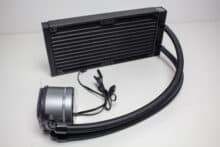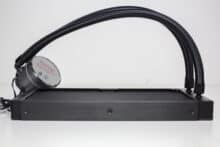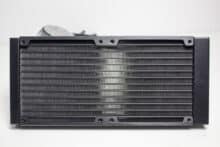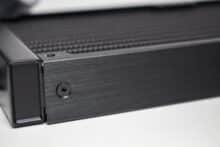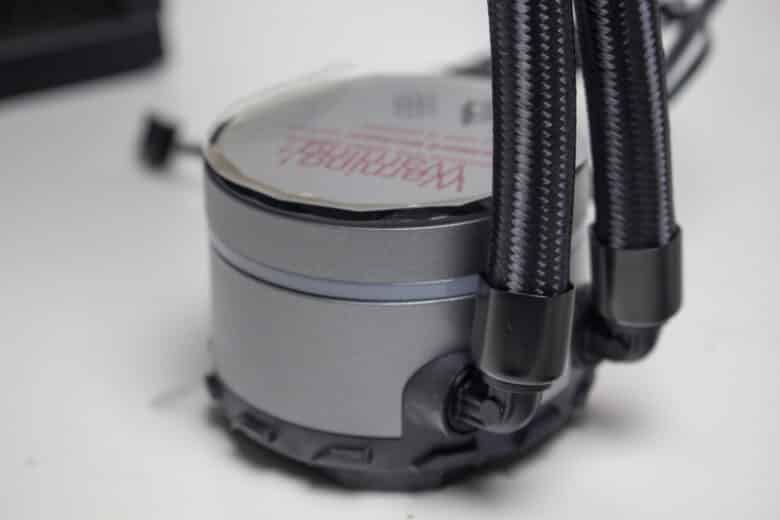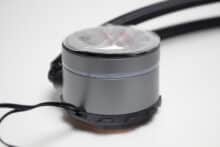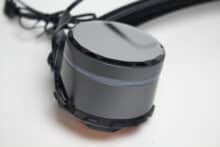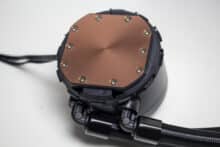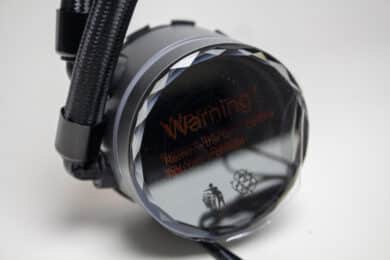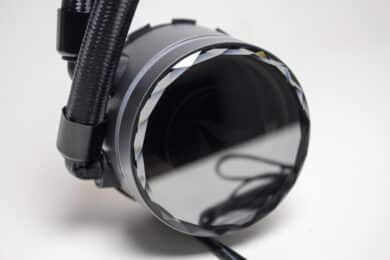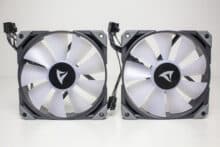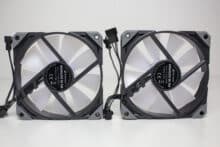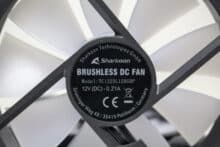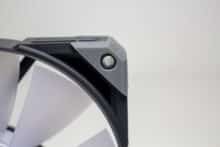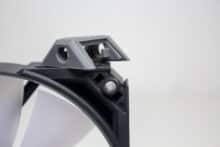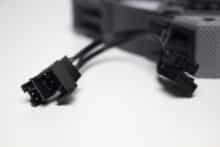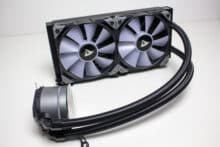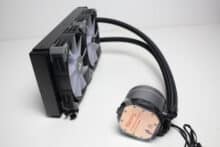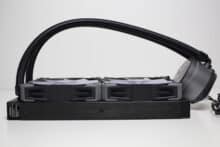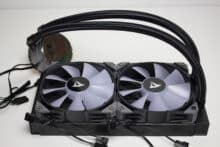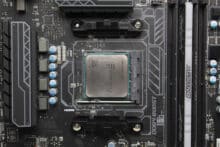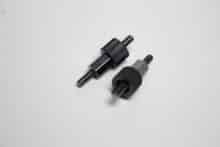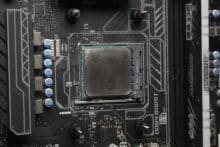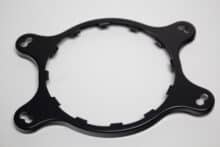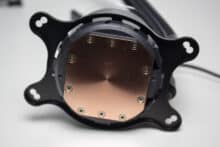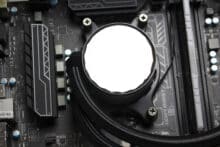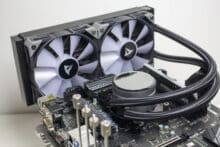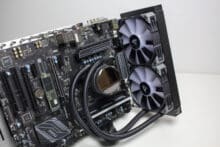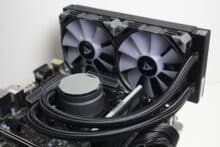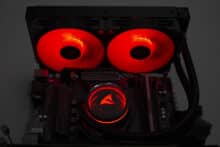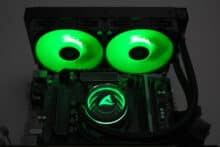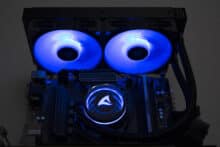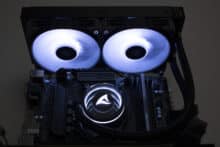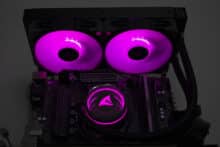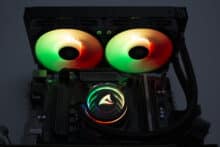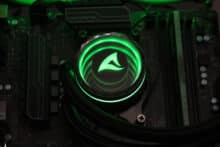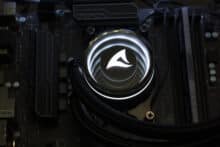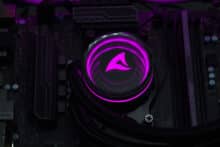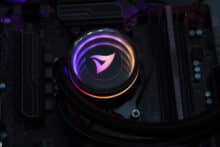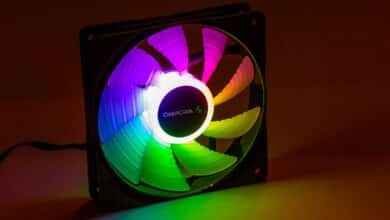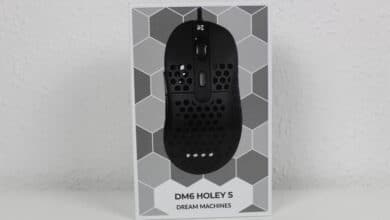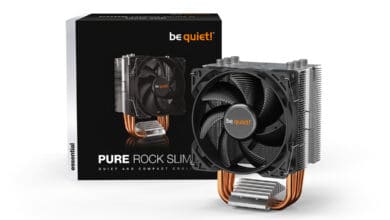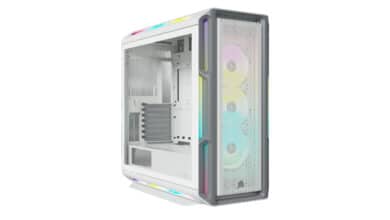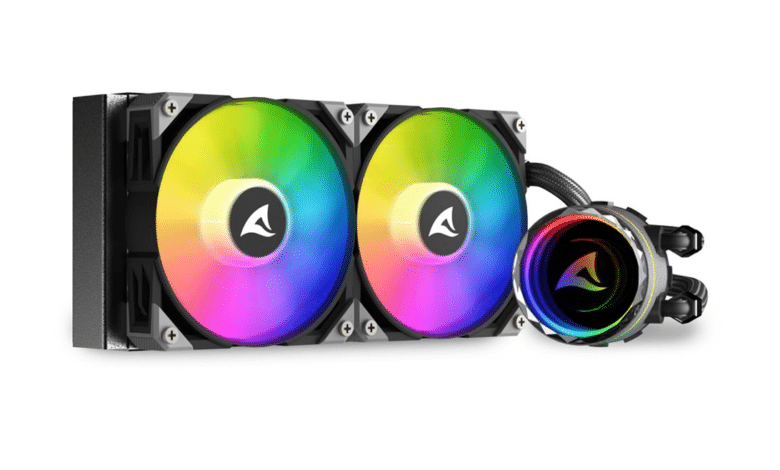
The name Sharkoon or Sharkoon Technologies GmbH stands for a German company founded in 2003 and based in Pohlheim (Germany) and Taiwan. The manufacturer specializes in the development of high-quality and affordable PC components and gaming products. The portfolio has so far included cases and power supplies, but also fans, mice, mouse pads, keyboards, headsets, chairs and other peripherals. Sharkoon has not yet gained a foothold in the CPU cooler segment. The manufacturer now wants to change that with a series of AiO water coolers. Today, we have the Sharkoon S80 RGB for you in review.
Sharkoon added the first AiO water coolers to its own portfolio in February 2023 with the S70 RGB, S80 RGB and S90 RGB. The S80 RGB is supposed to be a compact all-in-one water cooling system, which is supposed to provide efficient cooling for all CPUs with a 240-millimeter radiator and is also supposed to convince visually with the illuminated fans as well as pump elements with infinity mirror effect. Furthermore, the manufacturer mentions the high socket compatibility with easy installation, flexible as well as textile-covered hoses and a rotatable Sharkoon logo in the pump lid as features. What the AiO water cooling can do, learn here in the following chapters.
Sharkoon S80 RGB review: technical details
General specifications
| Weight | 1480 g |
| Compatibility AMD | TR4 / TRX4 / AM5 / AM4 / AM2 / FM2 / FM1 / AM3+ / AM2+ / AM2 |
| Compatibility Intel | LGA 115X / 1366 / 1200 / 1700 / 2011 / 2011-3 / 2066 |
| Cooling performance. |
N/A |
| Price |
€ 96.04 * |
Radiator specifications
| Type | Brazed radiator |
| Dimensions (L x W x H) | 272 x 121 x 27.5 mm |
| Material | Aluminum alloy |
Fan specifications
| Number of fans | 2 |
| Fan name | Sharkoon Brushless DC Fan |
| Bearing type | hydrodynamic plain bearing (HDB) |
| Dimensions (L x W x H) | 120 x 120 x 25 mm |
| Fan speed | 600 ~ 2,000 rpm ± 10% |
| Max. Noise | 35 db(A) |
| Max. Volume flow | 131.93 m³/h |
| Max. Air pressure | 2.90 mm H2O |
| Lighting | 12x addressable RGB LED (per fan) |
| Nominal voltage (fan) | 12 V |
| Nominal voltage (LEDs) | 5 V |
| Nominal current (fans) | 0.21 A |
| Nominal current (LEDs) | 0.54 A |
| Nominal power (fans) | 2.52 W |
| Nominal power (LEDs) | 2.7 W |
| Fan connector | 4-pin PWM |
| LED connector | 4-pin (5V-D-coded-G) |
| Fan cable length | 450 mm |
| LED cable length | 450 mm |
Pump specifications
| Dimensions | Ø 71.5 mm x 52.3 mm |
| Weight | 0.89 kg |
| Cooling plate material | copper |
| Pump speed | 1,600 ~ 3,200 rpm ± 6% |
| Nominal voltage (pump) | 12 V |
| Nominal voltage (LEDs) | 5 V |
| Nominal current (pump) | 0.35 A |
| Nominal current (LEDs) | 0.8 A |
| Nominal power (pump) | 4.2 W |
| Nominal power (LEDs) | 4.0 W |
| Pump connection | 4-pin PWM |
| LED connector | 4-pin (5V-D-coded-G) |
| Tube length. |
400 mm |
Packaging & Scope of delivery
Sharkoon packs the S80 RGB in a cardboard box made of color-printed cardboard on which the main colors black and white dominate. The manufacturer has also had some colorful product images printed on the packaging. Furthermore, you can find information about the type of CPU cooler and information about the most important features, all technical data as well as a listing of the package contents. All text elements were written in English and partly in other languages.
Inside the cardboard box, Sharkoon relies on a mold made of recycled cardboard and some protective plastic films for the radiator, hoses, the pump block, fans and other mounting materials to protect all the components. The scope of delivery includes the radiator, two 120 mm fans with RGB lighting, a backplate or mounting bracket made of metal, necessary mounting materials (screws, spacers, etc.), a small tube of thermal paste, connection cables and detailed installation instructions.
Design & Workmanship
Like many other manufacturers, Sharkoon relies on a plain aluminum radiator. The fins were soldered and painted black. You won’t find any manufacturer’s lettering or lighting elements. Instead, the two ends of the radiator are powder-coated black and the long sides are covered with a brushed aluminum cover plate. With a height of 27.5 millimeters, it is within the average height of many commercially available compact water cooling systems.
With a length of 400 millimeters, the water hoses are long enough to accommodate the radiator anywhere in a conventional midi tower. The rotating joints on the side of the pump block also contribute to this. Both on the radiator and on the side of the pump, the textile-coated hoses were pressed into metal sleeves. This makes the solution a closed system, where the cooling circuit can not be expanded.
As the basis of the pump block, Sharkoon relies on a base plate made of copper, which was incorporated into a pump housing made of plastic. To improve the appearance and value, the housing was also sheathed with an element of grayish aluminum. The pump built into the block spins between 1600 and 3200 rpm and connects to the motherboard via a 4-pin PWM connector.
On the other hand, in the lid of the pump we find a mirrored surface, behind which there are numerous RGB LEDs or an illuminated manufacturer’s logo, and which is surrounded by a diamond-look ring. When the illumination is activated, an infinity mirror effect appears. The LEDs are controlled via a 5V 3-pin cable from the mainboard. Furthermore, there is also another RGB strip around the side of the pump block. One last good feature is that the lid with the logo can be rotated. This way it never has to be upside down.
The included fans of the type “Sharkoon Brushless DC Fan” are made of a black or milky plastic and have a speed range of 600 to 2000 rpm. They are connected directly to the motherboard via a 4-pin PWM connector including a Y-switch. Furthermore, the fans have small gray rubber bumpers at the corners, which are supposed to prevent vibrations from being transmitted to the radiator or the case.
For the implementation of the lighting, 12 addressable RGB LEDs are used in the fan hub. The LEDs are controlled via a proprietary connector, which can be converted to a conventional 5V 3-pin ARGB connector via an adapter and connected to the RGB cable of the pump.
If you bring the radiator and fan together into one complete package, the combination is 52.5 millimeters high and weighs about 1.5 kilograms. Thus, the compact water cooling should also fit into cases that do not offer so much space for water cooling components. In terms of build quality, we could not find any workmanship or paint defects on the fans, radiator or pump unit. In addition, there were no bent fins or unsightly scratches.
Sharkoon S80 RGB review: assembly
For the review, we are using a test system on a benchtable. This allows us to rule out factors such as heat buildup in the case. The test system consists of the following components.
- AMD Ryzen 5 1400 @ 3.8 GHz at 1.25V
- MSI B350 PC Mate
- Crucial Ballistix Sport LT gray 32 GB DDR4-3000
- Corsair Force Series MP510 960GB Nvme
- Gigabyte AORUS GTX 1060 6G
- LC-Power LC550 V2.31 Platinum Series 550W
The installation procedure is identical for all of Sharkoon’s AiO water cooling systems. In the following, we explain the procedure on an AM4 mainboard. The installation on Intel works mostly analogously, except that a different mounting frame as well as the supplied backplate must be used.
First, we start with the preparation of the motherboard. Since the S80 RGB is attached to the backplate of the AMD retention module, the plastic brackets on the front of the motherboard have to be removed first. Instead, special spacers with threads on both sides are now screwed into the AMD backplate by hand. After that, you would install the radiator in the case. Since we are using a benchtable, this step is omitted.
Next, the pump block must be prepared and fitted with the correct retaining bracket. For this purpose, the pump block or the mounting frame have retaining lugs with the help of which the frame snaps in accordingly after a rotation and remains on the pump. After we have evenly distributed the thermal paste (Arctic MX-4) on the heatspreader of the CPU, the pump can be placed on the processor. In the last step, the mounting frame is firmly connected to the backplate’s spacers via four thumbscrews.
Overall, the mounting system used is easy to understand and the installation of the AiO water cooling was completed quickly or makes a solid impression. If there are any doubts during the installation, then these should be able to be eradicated by taking a look at the installation instructions. There, all steps are explained in detail with text and pictures.
Loudness and cooling performance
As pointed out in the previous chapter, we are using an AM4 system based on the Ryzen 5 1400 and the MSI B350 PC Mate as our test hardware. The Ryzen runs at 3.8 GHz at 1.25V. To warm up the processor, it was loaded with Prime95 for 15 minutes. The CPU’s temperature was then read out with the CPUID hardware monitor and the room temperature was around 20 °C during the measurements.
| wdt_ID | CPU-Kühler | Temperatur 50% PWM (in °C) | Temperatur 100% PWM (in °C) | Minimale Lüftergeschwindigkeit (in U/min) | Lüftergeschwindigkeit bei 50% PWM (in U/min) | Lüftergeschwindigkeit bei 100% PWM (in U/min) | Minimale Pumpengeschwindigkeit (in U/min) | Pumpengeschwindigkeit bei 50% PWM (in U/min) | Pumpengeschwindigkeit bei 100% PWM (in U/min) |
|---|---|---|---|---|---|---|---|---|---|
| 77 | Enermax AQUAFUSION ADV 360 | 50,20 | 50,10 | 1.460 | 2.100 | 2.230 | 3.200 | ||
| 78 | DeepCool LS520 SE | 51,40 | 50,00 | 1.460 | 2.200 | 2.100 | 3.020 | ||
| 79 | Alphacool Core Ocean T38 360mm | 52,20 | 49,30 | 1.600 | 2.500 | 1.800 | 3.200 | ||
| 80 | DeepCool Castle 280EX | 53,00 | 52,00 | 1.050 | 1.600 | ||||
| 81 | Raijintek Scylla Elite CA360 ARGB | 54,00 | 51,00 | 850 | 1.000 | 3.200 | 4.000 | ||
| 82 | DeepCool AS500 | 54,00 | 52,00 | 700 | 1.150 | ||||
| 83 | SilentiumPC Fera 5 Dual Fan | 55,00 | 53,00 | 730 | 1.300 | ||||
| 84 | ENDORFY Navis F360 | 55,50 | 49,40 | 1.200 | 1.975 | ||||
| 85 | Thermaltake CNPS10X Performa | 56,00 | 53,00 | 700 | 1.500 | ||||
| 86 | ALSEYE Xtreme X360 | 57,00 | 53,00 | 1.100 | 1.600 | ||||
| CPU-Kühler | Temperatur 50% PWM (in °C) | Temperatur 100% PWM (in °C) | Minimale Lüftergeschwindigkeit (in U/min) | Lüftergeschwindigkeit bei 50% PWM (in U/min) | Lüftergeschwindigkeit bei 100% PWM (in U/min) | Minimale Pumpengeschwindigkeit (in U/min) | Pumpengeschwindigkeit bei 50% PWM (in U/min) | Pumpengeschwindigkeit bei 100% PWM (in U/min) |
As can be seen from the table or the diagram, the CPU of our test system reaches a maximum of 55.7 °C (at 50% PWM fan and pump speed) or 51.7 °C (at 100% fan and pump speed) at full load. This places the Sharkoon S80 RGB in the front range of our test field. No critical temperatures are reached even in this worst-case scenario and there is still much more room for stronger CPUs or higher overclocking.
However, you have to accept a slightly higher noise level in return. Especially the fans are clearly audible from a closed case at full speed. At 50% PWM it is already much more pleasant, but still not really quiet. At the minimum speed of the pump (1780 rpm) and fan (580 rpm), both components are no longer really perceptible and can be described as “silent”. This condition lasts up to a speed of 800 rpm for the fans and 1900 rpm for the pump.
Sharkoon S80 RGB review: lighting options
The Sharkoon S80 RGB features various ARGB elements that can be controlled via the motherboard. These include the fans, whose fan hub has corresponding LEDs, as well as the pump block, where additional LEDs are located below the mirror plate. The control is done via the 3-pin 5V ARGB connector on the pump block. The fan connections are directly connected to the pump block via an included cable. This way the mainboard only needs a single ARGB connector to control the lighting. Finally, a few impressions of the activated lighting.
Summary of Sharkoon S80 RGB review
Can Sharkoon’s debut in the AiO water cooling segment be called a success? Basically, the Sharkoon S80 RGB offers all the prerequisites for this. The water cooling offers excellent workmanship as well as optics. The RGB illumination of the pump block with infinity mirror effect as well as the aluminum applications on the radiator and pump are particularly noteworthy. However, the mirror edge in diamond optics is a matter of taste. In addition, the S80 RGB can also convince in the area of cooling performance and comes with a solid mounting system. Also positive are the daisy-chain connections on the fan and pump, which should prevent a large cable tangle well.
As points of criticism of the S80 RGB, we would name the fans with proprietary RGB connection as well as the volume of the water cooling. However, the latter is true for almost all AiO water cooling systems. With an adjusted fan curve and reduced speeds, the volume can be lowered significantly, of course at the expense of the cooling performance. The proprietary RGB connectors are also not a major problem, as a suitable adapter is included and the connection to the pump is made via a standard connector.
Price-wise, the Sharkoon S80 RGB positions itself in the solid mid-range with € 96.04 *. There are cheaper but also significantly more expensive AiO watercoolers with 240mm radiaotr. These are similarly constructed and usually offer identical features. However, the manufacturers are often better known than Sharkoon. However, if you adjust the fan curves in the BIOS a bit and find the looks appealing, the Sharkoon S80 RGB is a solid and appropriately priced AiO water cooler. So the debut has been a success!
Sharkoon S80 RGB
Design
Workmanship
Mounting
Performance
Value for money
90/100
The Sharkoon S80 RGB offers a very good complete package of looks, workmanship, compatibility and cooling performance. However, as is almost always the case, this AiO water cooler also requires an adjustment of the fan curve if a bit of silence is to prevail.


